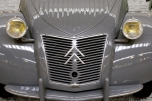Cars after 1950 - Modern Times
Maserati Type 250 F
1957
Code 1208
Body style: GP single-seater
The Maserati 250 F is one of the best-known Grand Prix cars from the post-war period, because of its association with a big name in racing: Juan Manuel Fangio. The 1957 250 F single-seater in the Cité de l’Automobile, Code 1208, is identical to the model that Fangio drove to his final world title, after which the Argentinean decided to retire from motor racing.
This car was born out of the work of engineers Colombo and Alfieri. Its sober lines were classical, but its mechanical design very modern. It boasted a six-cylinder inline 290 hp engine that powered the racer to more than 280 kph (170 mph). One unusual feature was the “De Dion” articulated rear tube axle on which the four-speed gear box was mounted. The secret to the car’s success was its light weight – weighing in at only 630 kg, thanks to an extremely well-balanced tubular chassis.
Juan Manuel Fangio started his career in Europe with Simca Gordini, before going on to success with Alfa Romeo, Ferrari and Mercedes. He was persuaded by the race results of Maserati to join the works team, replacing Stirling Moss. With the Maserati 250 F, he found a strong and precise car, that perfectly suited his perfectionist driving style.
The performance of the 250 F and Fangio’s own driving and mechanical skills ensured him a place in racing history, with this 5th successive World Championship title, which included a particularly spectacular win at the tricky Nürburgring circuit in the German Grand Prix. Fangio drove through the tight turns with breathtaking precision and was quoted after the race as saying, “I have never driven that quickly before in my life and I don’t think I will ever be able to do it again.”





















